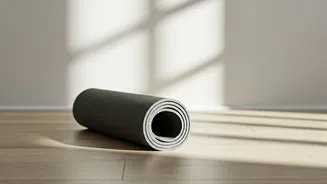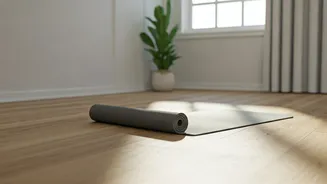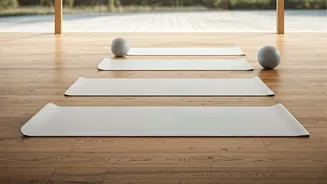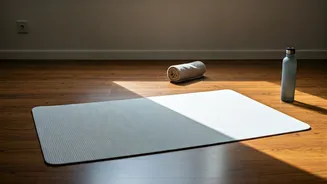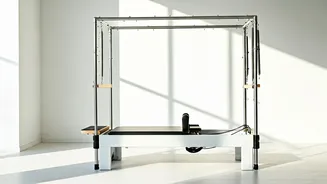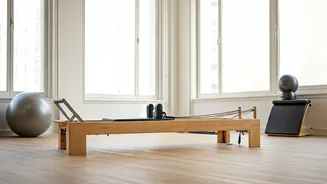Pilates Introduction
Pilates, a system of exercise, emphasizes core strength, flexibility, and body awareness. It's an excellent method for individuals of all fitness levels
to build strength without placing excessive strain on the joints. The focus is on controlled movements and precise form, which promotes better posture and balanced muscle development. Beginner exercises concentrate on establishing core stability, which acts as the foundation for more advanced routines. The beauty of Pilates lies in its adaptability; it can be adjusted to suit individual needs and capabilities, making it a sustainable and enjoyable fitness practice. This particular set of exercises doesn't require any equipment, making it an ideal choice for anyone looking to exercise at home. Whether your goal is to reduce stress, improve flexibility, or simply get moving, Pilates offers a comprehensive approach to enhance your well-being.
Hundred Exercise
The Hundred is a fundamental Pilates exercise that warms up the body and engages the core. To perform this, lie on your back with your knees bent or extended, and your head and shoulders lifted off the floor. Extend your arms to the sides, palms down. Begin pumping your arms up and down, inhaling for five counts and exhaling for five counts. Maintain a steady breath and core engagement throughout the exercise, aiming for ten sets of inhales and exhales. This exercise boosts circulation, increases core strength, and encourages better breathing. It may seem simple, but the controlled movements and emphasis on breath coordination make it quite effective. As a beginner, focus on maintaining good form rather than rushing through the repetitions. Remember that slow, controlled movements are key to benefiting from this exercise.
Roll Up Execution
The Roll Up exercise is designed to improve spinal flexibility and abdominal strength. Start by lying on your back with your legs extended and arms overhead. Engage your abdominal muscles to slowly roll your body up off the mat, vertebra by vertebra, reaching toward your toes. Keep your back rounded and your core engaged as you lift. Once you're fully seated, slowly reverse the motion, rolling back down, one vertebra at a time, until you return to the starting position. It's crucial to maintain control throughout, avoiding any jerky movements. The Roll Up enhances core stability, improves posture, and strengthens the abdominal muscles. The emphasis on controlled movements ensures each muscle is engaged and activated. Beginners can modify the exercise by bending their knees or using their hands for assistance during the rolling-up phase.
Single Leg Circles
Single Leg Circles primarily target the core and the lower body. Lie on your back with one leg extended towards the ceiling and the other bent, foot flat on the floor. Engage your core and draw small circles with the extended leg, maintaining a stable pelvis. Perform the circles clockwise and then counterclockwise, focusing on controlled movements. This exercise helps to increase leg flexibility, tone the inner thighs, and strengthen the abdominal muscles. Controlling the movement and preventing any side-to-side tilting of the pelvis is essential. The exercise is designed to improve coordination and balance while improving core control. As you build strength, gradually increase the size of the circles, always paying attention to maintain perfect form. Ensure you switch legs and perform the same number of repetitions on each side.
Rolling Like a Ball
Rolling Like a Ball is an effective exercise for massaging the spine and strengthening the core. Begin by sitting upright with your knees bent and feet lifted off the floor. Grasp your shins and roll back onto your upper back, maintaining the rounded shape of your spine, and immediately roll back up to the starting position. Keep your core engaged and your neck relaxed throughout the exercise, avoiding rolling onto your neck. This movement improves balance, enhances core stability, and provides a gentle massage to the spine. Rolling Like a Ball is designed to help improve coordination, focus, and core strength. For beginners, start by practicing the rocking motion without a full roll. You can modify the exercise by holding onto your thighs instead of your shins to help maintain control. It should be performed smoothly, with the movement driven by the core muscles rather than momentum.
Swimming Exercise
Swimming targets the back muscles and promotes core stability. Lie face down with arms extended forward and legs extended behind. Lift opposite arms and legs off the floor, engaging your back muscles, and then alternate. Perform this in a continuous, flowing motion, mimicking the movements of swimming. Maintaining a neutral spine is crucial to avoid any strain. This exercise strengthens the back muscles, tones the core, and improves coordination. Focus on lengthening the spine and engaging the back muscles to lift the limbs. Remember that keeping the core engaged throughout is essential to protect the lower back and prevent injury. By practicing the Swimming exercise consistently, individuals can improve their posture, build core strength, and boost overall fitness.



